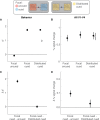Evidence for unlimited capacity processing of simple features in visual cortex
- PMID: 28654964
- PMCID: PMC5488877
- DOI: 10.1167/17.6.19
Evidence for unlimited capacity processing of simple features in visual cortex
Abstract
Performance in many visual tasks is impaired when observers attempt to divide spatial attention across multiple visual field locations. Correspondingly, neuronal response magnitudes in visual cortex are often reduced during divided compared with focused spatial attention. This suggests that early visual cortex is the site of capacity limits, where finite processing resources must be divided among attended stimuli. However, behavioral research demonstrates that not all visual tasks suffer such capacity limits: The costs of divided attention are minimal when the task and stimulus are simple, such as when searching for a target defined by orientation or contrast. To date, however, every neuroimaging study of divided attention has used more complex tasks and found large reductions in response magnitude. We bridged that gap by using functional magnetic resonance imaging to measure responses in the human visual cortex during simple feature detection. The first experiment used a visual search task: Observers detected a low-contrast Gabor patch within one or four potentially relevant locations. The second experiment used a dual-task design, in which observers made independent judgments of Gabor presence in patches of dynamic noise at two locations. In both experiments, blood-oxygen level-dependent (BOLD) signals in the retinotopic cortex were significantly lower for ignored than attended stimuli. However, when observers divided attention between multiple stimuli, BOLD signals were not reliably reduced and behavioral performance was unimpaired. These results suggest that processing of simple features in early visual cortex has unlimited capacity.
Figures





Similar articles
-
Attention improves encoding of task-relevant features in the human visual cortex.J Neurosci. 2011 Jun 1;31(22):8210-9. doi: 10.1523/JNEUROSCI.6153-09.2011. J Neurosci. 2011. PMID: 21632942 Free PMC article.
-
Independence of anticipatory signals for spatial attention from number of nontarget stimuli in the visual field.J Neurophysiol. 2008 Aug;100(2):829-38. doi: 10.1152/jn.00030.2008. Epub 2008 Jun 11. J Neurophysiol. 2008. PMID: 18550727 Free PMC article.
-
Direct evidence for attention-dependent influences of the frontal eye-fields on feature-responsive visual cortex.Cereb Cortex. 2014 Nov;24(11):2815-21. doi: 10.1093/cercor/bht157. Epub 2013 Jun 21. Cereb Cortex. 2014. PMID: 23794715 Free PMC article.
-
Popout modulates focal attention in the primary visual cortex.Neuroimage. 2004 Jun;22(2):574-82. doi: 10.1016/j.neuroimage.2004.01.031. Neuroimage. 2004. PMID: 15193585
-
A second-order orientation-contrast stimulus for population-receptive-field-based retinotopic mapping.Neuroimage. 2018 Jan 1;164:183-193. doi: 10.1016/j.neuroimage.2017.06.073. Epub 2017 Jun 27. Neuroimage. 2018. PMID: 28666882
Cited by
-
Severe processing capacity limits for sub-lexical features of letter strings.Atten Percept Psychophys. 2024 Feb;86(2):643-652. doi: 10.3758/s13414-023-02830-1. Epub 2024 Jan 3. Atten Percept Psychophys. 2024. PMID: 38172462 Free PMC article.
-
Spatial selectivity in visual detection suffers when attention is divided.Atten Percept Psychophys. 2025 May;87(4):1107-1131. doi: 10.3758/s13414-025-03066-x. Epub 2025 Apr 11. Atten Percept Psychophys. 2025. PMID: 40214937 Free PMC article.
-
Oscillations in an artificial neural network convert competing inputs into a temporal code.PLoS Comput Biol. 2024 Sep 11;20(9):e1012429. doi: 10.1371/journal.pcbi.1012429. eCollection 2024 Sep. PLoS Comput Biol. 2024. PMID: 39259769 Free PMC article.
-
Visual word recognition: Evidence for a serial bottleneck in lexical access.Atten Percept Psychophys. 2020 May;82(4):2000-2017. doi: 10.3758/s13414-019-01916-z. Atten Percept Psychophys. 2020. PMID: 31832892 Free PMC article.
-
Parallel spatial channels converge at a bottleneck in anterior word-selective cortex.Proc Natl Acad Sci U S A. 2019 May 14;116(20):10087-10096. doi: 10.1073/pnas.1822137116. Epub 2019 Apr 8. Proc Natl Acad Sci U S A. 2019. PMID: 30962384 Free PMC article.
References
-
- Awh, E.,& Pashler, H. E.. (2000). Evidence for split attentional foci. Journal of Experimental Psychology: Human Perception and Performance, 26, 834–846. - PubMed
-
- Bay, M.,& Wyble, B.. (2014). The benefit of attention is not diminished when distributed over two simultaneous cues. Attention, Perception & Psychophysics, 76, 1287–1297. - PubMed
-
- Beauchamp, M. S., Cox, R. W.,& DeYoe, E. A.. (1997). Graded effects of spatial and featural attention on human area MT and associated motion processing areas. Journal of Neurophysiology, 78, 516–520. - PubMed
-
- Bonnel, A.-M., Stein, J. F.,& Bertucci, P.. (1992). Does attention modulate the perception of luminance changes? Quarterly Journal of Experimental Psychology, 44A, 601–626. - PubMed
MeSH terms
Grants and funding
LinkOut - more resources
Full Text Sources
Other Literature Sources
Miscellaneous

